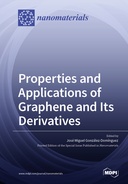Explore

Properties and Applications of Graphene and Its Derivatives
0 Ungluers have
Faved this Work
Login to Fave
Graphene is a two-dimensional, one-atom-thick material made entirely of carbon atoms, arranged in a honeycomb lattice. Because of its distinctive mechanical (e.g., high strength and flexibility) and electronic (great electrical and thermal conductivities) properties, graphene is an ideal candidate in myriad applications. Thus, it has just begun to be engineered in electronics, photonics, biomedicine, and polymer-based composites, to name a few. The broad family of graphene nanomaterials (including graphene nanoplatelets, graphene oxide, graphene quantum dots, and many more) go beyond and aim higher than mere single-layer (‘pristine’) graphene, and thus, their potential has sparked the current Special Issue. In it, 18 contributions (comprising 14 research articles and 4 reviews) have portrayed probably the most interesting lines as regards future and tangible uses of graphene derivatives. Ultimately, understanding the properties of the graphene family of nanomaterials is crucial for developing advanced applications to solve important challenges in critical areas such as energy and health.
This book is included in DOAB.
Why read this book? Have your say.
You must be logged in to comment.
Rights Information
Are you the author or publisher of this work? If so, you can claim it as yours by registering as an Unglue.it rights holder.Downloads
This work has been downloaded 84 times via unglue.it ebook links.
- 84 - pdf (CC BY) at Unglue.it.
Keywords
- 2D materials
- 2D-scaffolds
- amine
- antifriction
- antiwear
- application
- cadmium sulphide
- capacitance
- carbon nanofibers
- carbon nanotubes
- cement composite
- Characterization
- CO2 capture
- conductive inks
- Cryogel
- dyes
- effect of nanocomposites
- electrical properties
- electrical resistance
- electrocatalytic
- electrochemical synthesis
- electroluminescence
- Electronic and magnetic properties
- electronic transport
- Energy harvesting
- engine lubricant oil additives
- exfoliation degree
- few-layer graphene
- Fibers
- field electron emission
- film fabrication
- fluid loss
- Graphene
- graphene additives
- graphene oxide
- graphene-derived materials
- graphite
- graphyne-like materials
- Heavy metals
- hot-filament CVD
- hybrid light-emitting device
- Hydrogels
- hydrothermal reduction
- interlayer spacing
- Joule heating
- laser machining
- liquid-phase processing
- Lorentzian fitting
- mass production
- metal-free electrodes
- modified graphene nanoplates
- Morphology
- mud cake
- n/a
- nanocellulose
- Nanocrystals
- Nanotechnology
- optical limiting functionality
- oxidation level
- photodetectors
- physical exfoliation
- Pollutant Removal
- PVK
- Raman
- reduce graphene oxide
- reduced graphene oxide
- reduced graphene oxide nanofibers
- Reference, information & interdisciplinary subjects
- Research & information: general
- rheological
- rheology
- SERS spectroscopy
- shear exfoliation
- silico-phosphate composite films
- sol-gel
- stem cell differentiation
- strain sensing
- superlattice
- surface defects
- sustainability
- synthesis and doping
- TEM
- Thermal properties
- tissue regeneration
- ultrashort laser pulses
- UV-Vis
- UV-Vis spectroscopy
- water-based drilling fluids
- α-lipoic acid
Links
DOI: 10.3390/books978-3-0365-4784-8Editions

